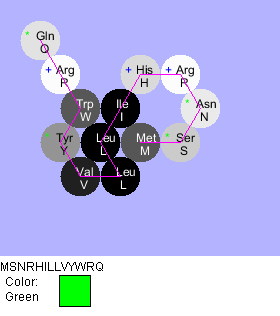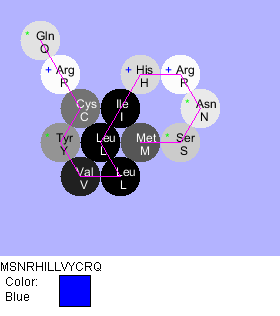Dcartmel Week 2
User Page Link
Template Page Link
Assignment Pages
Individual Journal Pages
- Dcartmel Week 2
- Dcartmel Week 3
- Dcartmel Week 4
- Dcartmel Week 5
- Dcartmel Week 6
- Dcartmel Week 8
- Dcartmel Week 9
- Dcartmel Week 10
- Dcartmel Week 11
- Dcartmel Week 13
- Dcartmel Week 14
- Class Journal Week 1
- Class Journal Week 2
- Class Journal Week 3
- Class Journal Week 4
- Class Journal Week 5
- Class Journal Week 6
- Class Journal Week 7
- Class Journal Week 8
- Class Journal Week 9
- Class Journal Week 10
- Class Journal Week 13
- Class Journal Week 14
Scientific Purpose
The purpose of this assignment is to determine the relationship between the amino acid sequence of a pigment protein and the overall color of the plant.
Combined Methods/Results
Procedure:
- First, using the Aipotu software, we compared the amino acid sequences and structures of the starting strains of green 1, green 2, red, and white in order to find any similarities or differences between their sequences or structures.
- We noticed that all of the pigmented proteins had a similar structure that included an aromatic ring, so we then focused on the differences found in the amino acid sequence.
- Focusing on the differences in the amino acid sequences that could be seen when comparing both upper and lower pigmented proteins, we utilized a trial and error method to determine what amino acids were necessary to produce certain pigments in the proteins.
- We then formulated rules that identified the particular amino acids and locations of such amino acids that were required to produce certain desired pigments.
- These rules were then presented to the class.
Questions:
A)Which proteins are found in each of the four starting organisms?
- green-1- green 1 has two green pigmented proteins.
- Green-2- green 2 has one blue pigmented protein and one yellow pigmented protein.
- Red- red has one red pigmented protein and one white pigmented protein.
- White- white has two white pigmented proteins.
This image shows the allele, its corresponding color, and the highlighted differences in the amino acid sequence that are required to produce this color.
C)What features of a protein make it colored?
- Particular amino acids need to be placed at certain positions at the end of the sequence and the overall structure of the protein needs to have an aromatic ring portion. The aromatic sequence has resonance due to the alternating single and double bonds which creates a pigment.
D)What features of the amino acid sequence make a protein a particular color?
- To make green, Tyr and Trp must be positioned in the tenth and eleventh spots from the left in the amino acid sequence.
- To make blue, Val, Try, and Cys must be positioned in the ninth, tenth, and eleventh spots from the left in the amino acid sequence.
- To make yellow, Trp must be positioned in the tenth spot from the left in the amino acid sequence.
- To make red, Phe and Cys must be postioned in the tenth and eleventh spots from the left in the amino acid sequence.
- To make black, Tyr, Trp, and Phe must be positioned in the ninth, tenth, and eleventh spots from the left in the amino acid sequence.
- To make purple, Tyr and Phe must be positioned in the tenth and eleventh spots from the left in the amino acid sequence.
- To make orange, Phe and Trp must be positioned in the tenth and eleventh spots from the left in the amino acid sequence.
- To make white, Val and Cys must be positioned in the tenth and eleventh spots from the left in the amino acid sequence.
E)How do the colors combine to produce an overall color? How does this explain the genotype-phenotype rules you found in part (I)?
- The colors combine to produce a new color through a process called incomplete dominance where the two original colors mix to form a new color. In our portion of this experiment, we found that when a green pigmented protein was combined with a yellow, green, or white pigmented protein, the resulting protein was green. When purple and orange or yellow were combined, the resulting protein was blue. When the red and yellow are combined, the resulting protein was orange. When red and blue were combined the resulting protein was purple. When purple and green were combined the resulting protein was black. Combining yellow and purple makes a red protein. A screenshot of the combination of red and blue sequences to produce a purple protein is included in the experiment part of the blog section of this report. This explains the genotype-phenotype rules because the combinations actually work and will produce the desired pigmented protein.
F)Show your TA that you have made a purple protein. For full credit, you need to explain why it is purple.
This is the purple protein. It was created following the rules that we outlined on how the purple pigmented protein is produced. This included having Tyr and Phe positioned in the tenth and eleventh spots from the left side of the amino acid sequence and also including an aromatic ring in the overall structure.
Blog Section
Hypothesis
- If the red and blue pigmented proteins are combined, then the resulting pigmented protein will be purple.
Experiments
- We took the red and blue pigmented proteins and folded them using the Aipotu software.
Results
- When red and blue pigmented proteins were combined, the result was a purple pigmented protein.
Conclusions
- Our hypothesis is accurate.
Scientific Conclusion
- In this experiment we determined how the amino acid sequence of particular pigment proteins specifies the overall color of the plant. We found that the structure of the pigmented proteins must include an aromatic ring because this structure has resonance through the alternating single and double bonds that it contains, which produces pigments. Also we found that certain amino acids must be placed in particular locations in the overall amino acid sequence in order for particular colored pigments to be produced. We found that these locations were either in the ninth, tenth, or eleventh spots from the left in the amino acid sequence.
Acknowledgements
- I worked with my homework partners Annika G. Dinulos and Lizzy Urbina during class on 1/24/20 and one time in the computer lab outside of class on 1/28/20. On 1/28/20, using the Aipotu software, we took screenshots of the different combinations of pigment proteins that we needed to include in our lab report.
- My group met with Kam D. Dahlquist, Ph.D. on 1/29/20 during office hours in order to obtain clarification on the questions outlined in the procedure.
- I copied and modified the Week 2 page.
- I copied and modified the syntax for formatting pictures from Help:Images.
- I copied and modified the protocol outlined in Part II: Biochemistry
- I used the Aipotu software: Aipotu (formerly Molecular Genetics Explorer) home page
- Except for what is noted above, this individual journal entry was completed by me and not copied from another source.
Dcartmel (talk) 20:58, 29 January 2020 (PST)
References
OpenWetWare. (2020).BIOL368/S20:Week 2. Retrieved January 29, 2020 from https://openwetware.org/wiki/BIOL368/S20:Week_2
Aipotu. (2017). Biochemistry. Retrieved January 29, 2020 from http://aipotu.umb.edu/
Help:Images. (2020). Retrieved January 29, 2020 from https://www.mediawiki.org/wiki/Help:Images









